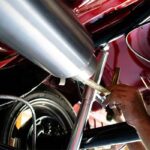Front-end car crashes are the most frequent type of collision, leading to a wide range of damage that can be complex to repair. Understanding the potential extent of this damage is crucial for both vehicle owners and repair professionals. This guide delves into the intricacies of front-end collision damage, outlining common affected areas and highlighting the importance of proper repair procedures.
Common Areas Affected in Front-End Collisions
The force of impact in a front-end collision can affect various components, from cosmetic damage to critical structural issues. Here are some key areas commonly damaged:
Bumper System
The bumper is the first line of defense, designed to absorb initial impact. Damage can range from minor scratches and dents to complete bumper detachment. Underlying components like the reinforcement bar and energy absorbers can also be affected.
Lighting and Grille
Headlights, fog lights, and the grille are highly susceptible to damage in a frontal collision. Broken lenses, damaged housings, and misalignment are common occurrences.
Hood and Fenders
The hood and fenders can suffer significant damage, including dents, creases, and tears. Severe impacts can cause the hood to buckle or the fenders to deform, potentially affecting wheel alignment.
Cooling System
The radiator, condenser, and other cooling system components located at the front of the vehicle are vulnerable to damage. Leaks, punctures, and fan damage can result from a front-end collision.
Suspension and Steering
The impact force can transfer to the suspension and steering systems, potentially causing misalignment, bent control arms, and damaged tie rods. This can significantly affect vehicle handling and safety.
Frame Damage
Perhaps the most serious consequence of a front-end collision is frame damage. Even seemingly minor impacts can cause subtle frame bending or twisting, compromising structural integrity and vehicle safety. Specialized equipment and techniques are required to diagnose and repair frame damage accurately.
Engine and Transmission
In severe front-end collisions, the engine and transmission can sustain damage. This can range from cracked housings and fluid leaks to internal component damage requiring extensive repairs or replacement.
The Complexity of Modern Vehicle Repairs
Modern vehicles are equipped with advanced safety features and driver-assistance systems (ADAS), many of which are located in the front end. These systems, including radar sensors, cameras, and lidar, require precise calibration after a collision to ensure proper functionality. Even minor damage to these components can necessitate recalibration or replacement, adding complexity and cost to repairs.
The Importance of Professional Repair
Addressing front-end car crash damage properly is paramount for ensuring vehicle safety and performance. Qualified collision repair technicians possess the expertise and specialized equipment to accurately assess the extent of the damage, including hidden structural issues. They can employ the correct repair procedures, adhering to manufacturer specifications and utilizing appropriate tools to restore the vehicle to its pre-accident condition. This includes addressing frame damage, aligning suspension components, and calibrating ADAS systems.
Conclusion
Front-end car crash damage can encompass a wide range of issues, from minor cosmetic blemishes to significant structural and mechanical problems. Understanding the potential extent of this damage and the importance of professional repair is crucial for vehicle owners. Seeking the services of a qualified collision repair facility equipped with the latest technology and expertise ensures the vehicle is restored to its pre-accident condition, guaranteeing both safety and optimal performance.

